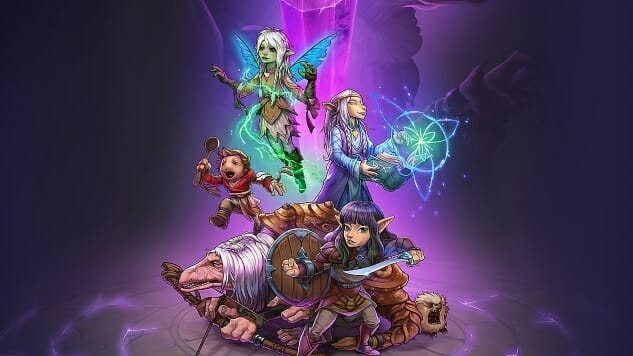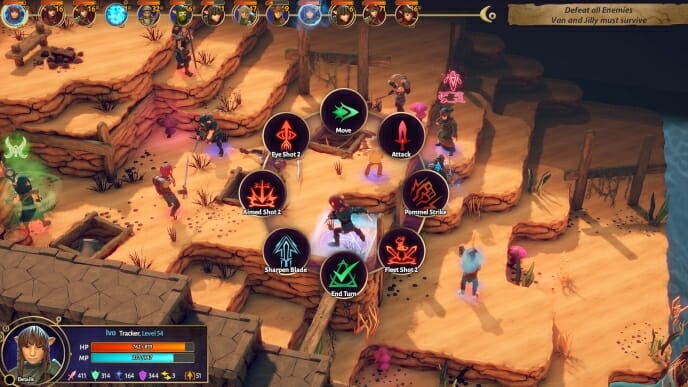The Dark Crystal: Age Of Resistance Tactics Doesn’t Know Why It Exists
Games Reviews Dark Crystal: Age of Resistance Tactics
For a game about social unrest, The Dark Crystal: Age Of Resistance Tactics says remarkably little about the subject. In fact, it says very little about anything in particular. Given its E10+ rating, perhaps it’s a problem of its intended audience—the fear of edging that rating to a dreaded T seems to make the game avoid any kind of thematic depth.
It’s not that Crystal couldn’t make a statement. The strategy RPG genre is filled with defining titles such as Final Fantasy Tactics and the Fire Emblem franchise that have their own unique takes on war and how that affects those that fight in them. Funny enough, Fire Emblem’s Game Boy Advance offerings said more about conflict with far fewer resources while boasting an E rating, featuring little more than pixel portraits and abstracted maps. Take Sacred Stones, for example: the continent of Magvel, much like the world of Thra, is divided into several geographic regions, but Sacred Stones feels more complete as a world than Crystal’ take on Thra, and the strife that permeates Magvel is communicated and felt—you worry for its characters, of which there are upwards of 30 playable units, more than Crystal’s hollow takes on beloved and comparatively small cast.
It’s a shame, because the groundwork is there—Dark Crystal has an enchanting world with well-explored lore, rich characterization, and thought out history, but all of that is lost in the game. Dark Crystal is, of course, known for Jim Henson’s incredible puppetry work. Here, we have lifeless 3D models with short looping animations devoid of identity. You get none of Deet’s crunchy gentleness, or any of Brea’s headstrong wit. Instead, you’re left with 14 interchangeable units, which, for all intents and purposes, are effectively the same in terms of what they can do in battle. You get a better sense of Disgaea’s creatable units, who have no speaking lines. They, at the very least, have colorful art and purposeful animations.
In contrast to character-driven strategy RPGs like Final Fantasy Tactics and Fire Emblem, I felt overwhelmed with the 14 playable characters present in Crystal. Most maps allow you to deploy four units, and given the very light amount of customization present in the game, there’s absolutely no way you’ll need to use more than a handful of them. Even if you wanted to, the game makes it near impossible to keep them all amply equipped. I barely even know who these characters are—almost all of them are introduced through a series of non-sequiturs, absent of any emotional payoff. When Gurjin is captured by the Skeksis and tortured, I asked myself “Wait, who was Gurjin again? Was he the scout or the soldier in the last battle?”

Any story elements that are too complex to be depicted through vapid dialogue are presented in a short comic strip-esque segment, which remains one of Crystal’ only points of visual interest. While the art is beautifully vivid, it still lacks the magic present in the show’s lovingly detailed depiction of Thra. Interesting lore is compartmentalized into dull playable mechanics that don’t add any depth to the action; the intimate and multifaceted act of dreamfasting is a simple move to recover MP, while female gelflings’ innate ability to fly is an alternative form of movement. Given flying takes up a whole turn without the option to act after, you’ll rarely be doing this unless absolutely necessary.
If you remove the pastiche of Dark Crystal’s aesthetic, you’re left with an okay strategy game. It never gets too deep, and despite a decently interesting class-system that blurs the lines between the classic RPG trio (Soldier, Thief, Mage), there’s almost no incentive to get that deep with it. Most battles can be won with the simplest of strategies—I played much of the game idly while watching the show, wondering why Rian simultaneously failed to instill any emotion in me in Crystal while making me cry in the Netflix show. In gameplay and story, there’s a halfhearted allusion to depth, a gesture towards a better game, but ultimately, like many videogames adapted from on-screen IPs, Crystal is a vapid companion piece to a much better show.
If Crystal were a mobile game, it would be a cut above many of its peers. Winning battles and leveling classes is pleasing like any game, but Crystal is idle enough to play one-handed. It’s not predatory in any way, meaning it would be viable as a healthy alternative to wallet-poisoning gacha games (hi, Fire Emblem Heroes). Unfortunately, Crystal was created with home consoles in mind, so you’re left wondering why anyone in their right mind would purchase Crystal over the readily available Fire Emblem: Three Houses or Wargroove. Crystal, as a whole, feels poorly thought out, with undercooked ideas and a true identity crisis. There could be too many numbers for children to play (hell, the math was lost on me too—I often found myself rapidly attacking without considering hit rates at all), but adults will find battles tedious and unintuitive. Not even fans of the Dark Crystal franchise will find a lot here, as the game rarely attempts to deepen or enrich the established lore.
Once you complete Crystal, you’re allowed, like many games, to retain your save and begin again with additional difficulty. I won’t be doing that. Instead, I’ll be replaying Muppet Treasure Island, the reigning champion of Jim Henson-verse videogames since 1996.
Dark Crystal: Age of Resistance Tactics was developed by BonusXP and published by En Masse Entertainment. Our review is based on the Switch version. It’s also available for Xbox One, PlayStatio 4, PC and Mac.
Austin Jones is an intern at Paste. He writes about music, video games, and queer issues. He’s an avid fan of electronic and pop music, horror games, Joanna Newsom, and 80s-90s anime. You can follow him on Twitter @belfryfire.